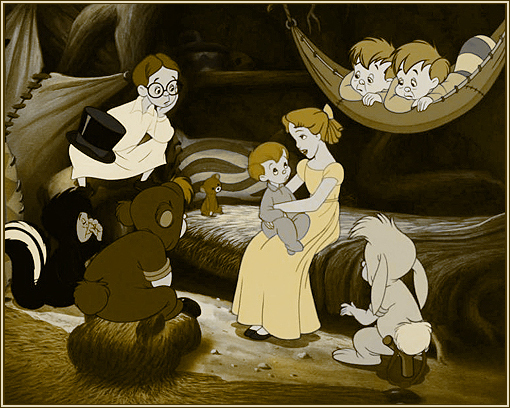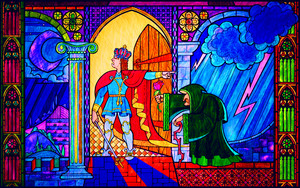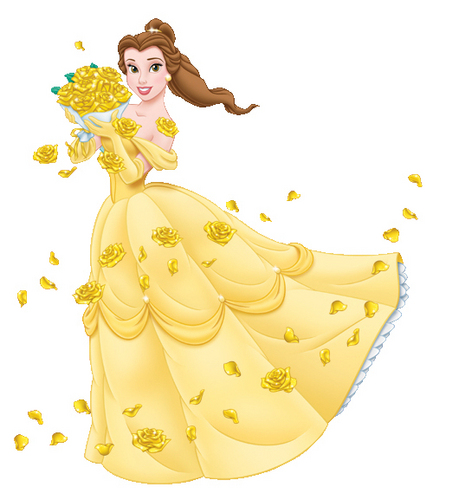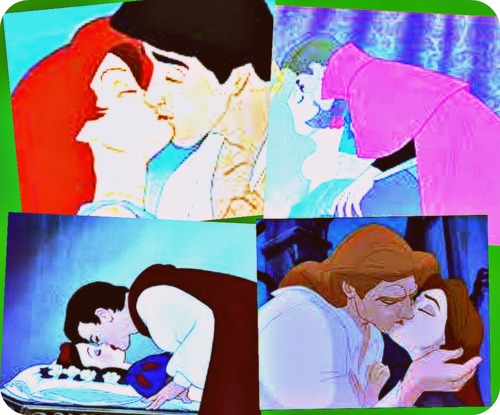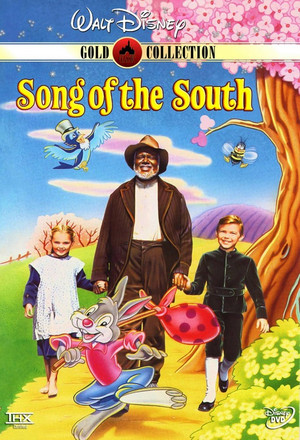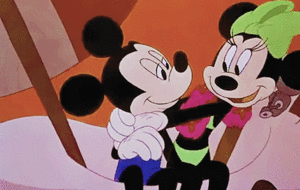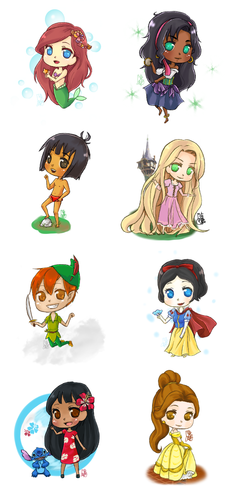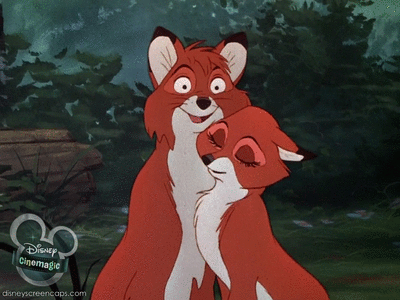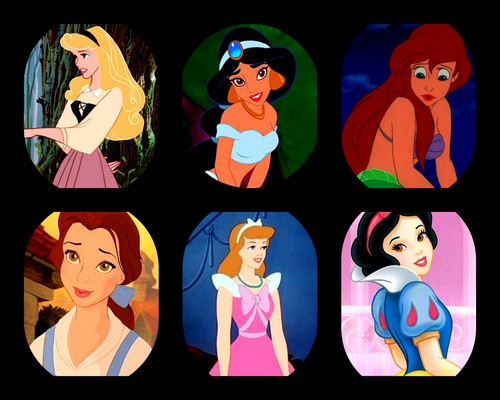Fairy tales are good to think with.
Compact yet also capacious, with
roots in myth, they were engineered
to accommodate changes in cultural
values and conflicts. “Snow White”
is no exception. Rupert Sanders’s
film “Snow White and the
Huntsman” the latest version of the
tale, takes us into a wilderness of
environmental depredations and
dynastic conflict. Charlize Theron’s
fair-haired wicked queen presides
over subjects with ravaged faces in
landscapes that resemble toxic oil
spills; in her shape-shifting magic,
she reconstitutes herself at one point
from what looks like a flock of crows
caught in an oil slick. Her rule has
no doubt created the viscous black
horrors that Snow White encounters
in the denuded woods to which she
flees. The film’s raven-haired
heroine, por contrast, soothes savage
beasts with her compassionate face
and, as a digitally miniaturized Bob
Hoskins, playing one of the seven
dwarfs, proclaims: “she will heal the
land.” But she’s no passive, guiltless
damsel. Her exquisite beauty,
combined with charismatic
leadership, enables her to defeat the
evil queen and redeem the desolate
landscape of the kingdom.
This Snow White is very different
from the one we find in the
canonical literary version recorded
in the early nineteenth century. The
Brothers Grimm called their story
“Little Snow White,” to emphasize
the innocence and vulnerability of a
young girl persecuted por her jealous
stepmother. Their heroine is
precociously stunning—“When she
was seven years old she was as
beautiful as the light of day, even
más beautiful than the queen
herself”—and her beauty inspires
huntsman, dwarfs, and prince alike
to protect her from a less fair,
wicked queen. The early tale is also
a reflection on children’s fears
about the cruelty of stepmothers, at
a time when mortality rates for
child-bearing women were
exceptionally high. The concept of
the “blended” family was foreign to
the Grimms’ era, and it remains so
in new inflections of the tale. Snow
White delivers a timely message
about survival even when the odds
are not in your favor, as they surely
are not for the heroine of “Snow
White and the Huntsman,” who
must now stand up to both a
perverse stepmother and a hostile
Mother Nature.
A 1912 Broadway musical first gave
the story the título por which we know
it today: “Snow White and the Seven
Dwarfs.” The miniature miners of
the Grimms’ tale now had whimsical
names and personalities—an
antidote to the tale’s dark themes.
The disney version (from 1937), too,
draws much of its charm from the
allegorical vigor of Doc, Grumpy,
Happy, Sleepy, Bashful, Sneezy and
Dopey, and, in addition, gives Snow
White a new mission. The Grimms’
girl was something of an intruder, a
Goldilocks figure who discovers an
enviably “neat and clean” cottage,
along with seven little beds—one
“just right”—covered with white
sheets. Disney’s heroine, por contrast,
is dado a Depression-era work ethic
and cleans up a house that appears
to be occupied por what she
disapprovingly refers to as “seven
untidy little children.” Whistling
while she works, she is a kindred
spirit to the dwarfs, who descend
into the mines to carry out their
subterranean work “from early
morn ’til night,” yet cheerfully
intone: “we don’t know / what we
dig ’em for.” Something of a “dumb
bunny,” as the Anne Sexton calls her
in a poem from “Transformations,”
Snow White falls victim three times
to the camouflaged wicked queen.
Grimm purists regard the Disney
version as a sentimental confection,
but disney animators preserved the
fairy tale’s powerful engagement
with a child’s fears about parental
persecution and abandonment,
while also capturing adult anxieties
about aging and loss. After drinking
the magic cóctel, coctel she has brewed,
the queen’s hair turns white, her
hands become gnarled with age
(“Look, my hands!”), her voice turns
into a throaty cackle (“My voice!”),
and finally she emerges from under
her dark capa as a hunchbacked
crone. The horror of the queen’s
transformation from a beautiful
woman into an abject old hag is still
potent.
Anne Sexton may well have had
Disney’s transformation scene in
mind when her wicked queen
condemns Snow White to be
“hacked” to death after she herself
discovers “brown spots on her hand”
and “four whiskers over her lip.”
Sexton’s emphasis on the stepmother
prefigured the nineteen-seventies
protests against the Disneyfication of
fairy tales, with Sandra Gilbert and
Susan Gubar leading the charge in
their preface to “The Madwoman in
the Attic,” a landmark work of
feminist criticism. They proposed
calling the story “Snow White and
Her Wicked Stepmother,” arguing
that the queen—inventive, active,
and mobile—was far more
enthralling than her insipid
stepdaughter.
With “Snow White and the
Huntsman,” the tale has been
reconceived to appeal to an
audience partial to high-decibel
special effects, monsters and
vampires, triangulated teen
romance, epic battle scenes, and
young warrior women who, like
Katniss Everdeen in “The Hunger
Games” o Merida in Pixar’s
“Brave,” have appropriated not only
the wicked queen’s inventive energy
but also the huntsman’s proficiency
with weapons. The film preserves
the central motifs of the Snow White
plot: mother-daughter rivalry, magic
mirror, compassionate huntsman,
seven dwarfs, poisoned apple, and
redemptive kiss—with all but the last
steroid-enhanced through high-tech
cinematic magic. Like all fairy-tale
adaptations, it also operates like a
magnet, picking up relevant bits and
pieces of the culture that is recycling
the tale.
Kristen Stewart’s Snow White is
nothing like the charmingly goofy
princess of Disney’s live-action
“Enchanted” o the spunky yet
vulnerable Snow White in ABC’s
series “Once Upon a Time.” More
like a serious cousin to the spirited
and radiantly youthful Snow White
of Tarsem Singh’s campy recent
film, “Mirror Mirror,” she is ready
for action. This Snow White becomes
a “pure and innocent” warrior
princess, an angelic savior who
channels Joan of Arc and Tolkien’s
Aragorn, as well as the four Pevensie
siblings from C. S. Lewis’s “The
Chronicles of Narnia,” to save the
kingdom of her late father (stabbed
to death por the queen on their
wedding night). Everyone is armed,
and swords, scimitars, axes, snares,
and shields feature as prominently
in this film as they do in the Middle
Earth of “The Hobbit.” Romance is
edged out por the racing energy of
caballos speeding through dramatic
landscapes and por expertly
choreographed combat scenes. This
is a Snow White designed to appeal
to viewers of all ages, and to men
and women alike.
“Snow White and the Huntsman”
captures deepening anxiety about
aging and generational sexual
rivalry in clever, self-reflexive ways,
with Charlize Theron as a beautiful
cougar (and established Hollywood
star) threatened por a younger, sylph-
like Kristin Stewart. In the world of
the film, beauty is the locus of
female power, and is thereby
fleeting in its effects (men are
“enchanted” por women but “use”
them until they eventually “tire” of
them); it is the fuente of both
fascination and horror. Early on, we
learn the wicked queen’s backstory:
she was abandoned por her first
husband for a younger woman. This
is meant to explain why she is so
desperate to suck the life force out of
local virgins, to dine on the vital
organs of birds, and to reap the
cosmetic effects of baths in
mysterious white fluids.
The queen’s quest for lasting youth
is part of the story’s larger
exploration (in the tradition of
many great myths) of how humans
relate to the natural world—whether
we are of it o have mastered and
moved beyond it. Efforts to remain
forever young violate the natural
order of generational succession and
imperil life itself. The woods have
always been terrifying, but never
más so than in this new version of
the tale, in which a despoiled Mother
Nature mirrors and magnifies the
wicked queen’s frenzied assaults on
humans. “Snow White and the
Huntsman” holds a mirror up to our
own vanity, narcissism, and
recklessness, emphatically
reminding us, as Charlize Theron
proclaims shortly before her
downfall, that every world gets the
wicked queen it deserves.
Compact yet also capacious, with
roots in myth, they were engineered
to accommodate changes in cultural
values and conflicts. “Snow White”
is no exception. Rupert Sanders’s
film “Snow White and the
Huntsman” the latest version of the
tale, takes us into a wilderness of
environmental depredations and
dynastic conflict. Charlize Theron’s
fair-haired wicked queen presides
over subjects with ravaged faces in
landscapes that resemble toxic oil
spills; in her shape-shifting magic,
she reconstitutes herself at one point
from what looks like a flock of crows
caught in an oil slick. Her rule has
no doubt created the viscous black
horrors that Snow White encounters
in the denuded woods to which she
flees. The film’s raven-haired
heroine, por contrast, soothes savage
beasts with her compassionate face
and, as a digitally miniaturized Bob
Hoskins, playing one of the seven
dwarfs, proclaims: “she will heal the
land.” But she’s no passive, guiltless
damsel. Her exquisite beauty,
combined with charismatic
leadership, enables her to defeat the
evil queen and redeem the desolate
landscape of the kingdom.
This Snow White is very different
from the one we find in the
canonical literary version recorded
in the early nineteenth century. The
Brothers Grimm called their story
“Little Snow White,” to emphasize
the innocence and vulnerability of a
young girl persecuted por her jealous
stepmother. Their heroine is
precociously stunning—“When she
was seven years old she was as
beautiful as the light of day, even
más beautiful than the queen
herself”—and her beauty inspires
huntsman, dwarfs, and prince alike
to protect her from a less fair,
wicked queen. The early tale is also
a reflection on children’s fears
about the cruelty of stepmothers, at
a time when mortality rates for
child-bearing women were
exceptionally high. The concept of
the “blended” family was foreign to
the Grimms’ era, and it remains so
in new inflections of the tale. Snow
White delivers a timely message
about survival even when the odds
are not in your favor, as they surely
are not for the heroine of “Snow
White and the Huntsman,” who
must now stand up to both a
perverse stepmother and a hostile
Mother Nature.
A 1912 Broadway musical first gave
the story the título por which we know
it today: “Snow White and the Seven
Dwarfs.” The miniature miners of
the Grimms’ tale now had whimsical
names and personalities—an
antidote to the tale’s dark themes.
The disney version (from 1937), too,
draws much of its charm from the
allegorical vigor of Doc, Grumpy,
Happy, Sleepy, Bashful, Sneezy and
Dopey, and, in addition, gives Snow
White a new mission. The Grimms’
girl was something of an intruder, a
Goldilocks figure who discovers an
enviably “neat and clean” cottage,
along with seven little beds—one
“just right”—covered with white
sheets. Disney’s heroine, por contrast,
is dado a Depression-era work ethic
and cleans up a house that appears
to be occupied por what she
disapprovingly refers to as “seven
untidy little children.” Whistling
while she works, she is a kindred
spirit to the dwarfs, who descend
into the mines to carry out their
subterranean work “from early
morn ’til night,” yet cheerfully
intone: “we don’t know / what we
dig ’em for.” Something of a “dumb
bunny,” as the Anne Sexton calls her
in a poem from “Transformations,”
Snow White falls victim three times
to the camouflaged wicked queen.
Grimm purists regard the Disney
version as a sentimental confection,
but disney animators preserved the
fairy tale’s powerful engagement
with a child’s fears about parental
persecution and abandonment,
while also capturing adult anxieties
about aging and loss. After drinking
the magic cóctel, coctel she has brewed,
the queen’s hair turns white, her
hands become gnarled with age
(“Look, my hands!”), her voice turns
into a throaty cackle (“My voice!”),
and finally she emerges from under
her dark capa as a hunchbacked
crone. The horror of the queen’s
transformation from a beautiful
woman into an abject old hag is still
potent.
Anne Sexton may well have had
Disney’s transformation scene in
mind when her wicked queen
condemns Snow White to be
“hacked” to death after she herself
discovers “brown spots on her hand”
and “four whiskers over her lip.”
Sexton’s emphasis on the stepmother
prefigured the nineteen-seventies
protests against the Disneyfication of
fairy tales, with Sandra Gilbert and
Susan Gubar leading the charge in
their preface to “The Madwoman in
the Attic,” a landmark work of
feminist criticism. They proposed
calling the story “Snow White and
Her Wicked Stepmother,” arguing
that the queen—inventive, active,
and mobile—was far more
enthralling than her insipid
stepdaughter.
With “Snow White and the
Huntsman,” the tale has been
reconceived to appeal to an
audience partial to high-decibel
special effects, monsters and
vampires, triangulated teen
romance, epic battle scenes, and
young warrior women who, like
Katniss Everdeen in “The Hunger
Games” o Merida in Pixar’s
“Brave,” have appropriated not only
the wicked queen’s inventive energy
but also the huntsman’s proficiency
with weapons. The film preserves
the central motifs of the Snow White
plot: mother-daughter rivalry, magic
mirror, compassionate huntsman,
seven dwarfs, poisoned apple, and
redemptive kiss—with all but the last
steroid-enhanced through high-tech
cinematic magic. Like all fairy-tale
adaptations, it also operates like a
magnet, picking up relevant bits and
pieces of the culture that is recycling
the tale.
Kristen Stewart’s Snow White is
nothing like the charmingly goofy
princess of Disney’s live-action
“Enchanted” o the spunky yet
vulnerable Snow White in ABC’s
series “Once Upon a Time.” More
like a serious cousin to the spirited
and radiantly youthful Snow White
of Tarsem Singh’s campy recent
film, “Mirror Mirror,” she is ready
for action. This Snow White becomes
a “pure and innocent” warrior
princess, an angelic savior who
channels Joan of Arc and Tolkien’s
Aragorn, as well as the four Pevensie
siblings from C. S. Lewis’s “The
Chronicles of Narnia,” to save the
kingdom of her late father (stabbed
to death por the queen on their
wedding night). Everyone is armed,
and swords, scimitars, axes, snares,
and shields feature as prominently
in this film as they do in the Middle
Earth of “The Hobbit.” Romance is
edged out por the racing energy of
caballos speeding through dramatic
landscapes and por expertly
choreographed combat scenes. This
is a Snow White designed to appeal
to viewers of all ages, and to men
and women alike.
“Snow White and the Huntsman”
captures deepening anxiety about
aging and generational sexual
rivalry in clever, self-reflexive ways,
with Charlize Theron as a beautiful
cougar (and established Hollywood
star) threatened por a younger, sylph-
like Kristin Stewart. In the world of
the film, beauty is the locus of
female power, and is thereby
fleeting in its effects (men are
“enchanted” por women but “use”
them until they eventually “tire” of
them); it is the fuente of both
fascination and horror. Early on, we
learn the wicked queen’s backstory:
she was abandoned por her first
husband for a younger woman. This
is meant to explain why she is so
desperate to suck the life force out of
local virgins, to dine on the vital
organs of birds, and to reap the
cosmetic effects of baths in
mysterious white fluids.
The queen’s quest for lasting youth
is part of the story’s larger
exploration (in the tradition of
many great myths) of how humans
relate to the natural world—whether
we are of it o have mastered and
moved beyond it. Efforts to remain
forever young violate the natural
order of generational succession and
imperil life itself. The woods have
always been terrifying, but never
más so than in this new version of
the tale, in which a despoiled Mother
Nature mirrors and magnifies the
wicked queen’s frenzied assaults on
humans. “Snow White and the
Huntsman” holds a mirror up to our
own vanity, narcissism, and
recklessness, emphatically
reminding us, as Charlize Theron
proclaims shortly before her
downfall, that every world gets the
wicked queen it deserves.


